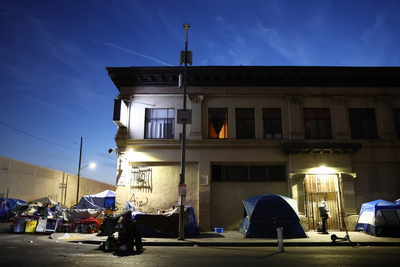
(NewsNation) — Over the summer, physician Brett Feldman of the University of Southern California was alerted to a homeless man with a severe wound on one of his arms.
"It was so bad, I wasn't sure he was going to keep his arm. I thought he was going to need an amputation," Feldman said.
The man was initially resistant to care. He was experiencing what Feldman described as an "acute psychotic episode," believing people were placing hot pokers in his arm. He wouldn't let anyone touch it.
But Feldman and his team kept meeting with the man day after day. They talked with him, shared food with him and were gradually able to clean the wound and then dress it.
The doctors saved his arm and got him treatment from a psychiatrist.
This was possible thanks to USC's Street Medicine team, which Feldman directs.
Although street medicine was pioneered in the 1990s and now takes place all over the United States, USC began its program in 2018.
Feldman — who had worked in street medicine elsewhere before coming to USC — was taken aback by the level of need in California.
"I had seen homelessness all over the world, and I was just blown away by the crisis in California. It was like nothing I had ever seen," he said.
Unlike traditional medical care, street medicine meets and treats homeless people where they are — on the street.
Street medicine teams are diverse groups, including physicians, nurses and medical students along with social workers, therapists, psychiatrists, and HIV specialists. Additionally, formerly homeless community social workers act as "street guides" for the team, relying on their experience.
Many of their patients often face difficulty getting to a brick-and-mortar location, making the on-site treatment so important, Feldman said.
He said that when he started working in street medicine years ago, the primary goal was to get the patients into a clinic eventually.
But they saw that this wasn't working.
Addiction and mental illness make it difficult for patients to keep track of scheduled visits. Financial precarity can also prevent patients from making it to a doctor's office.
"If they're going to panhandle and they're going to spend all day panhandling, they have this impossible decision: Are they going to spend the money on one of those two, three meals a week or on a bus pass to get to their [primary care physician] and not eat that day?" Feldman said.
He also pointed to the logistics of street life as making it difficult for patients to plan clinic visits.
"One that we often forget is what's called wait times exceeding the planning horizon," Feldman said. "So even if we reach our goal, which is fairly standard, in getting somebody an appointment within a week, but their planning horizon is only two days because of the chaos of the streets, they will forget that they have an appointment."
USC Street Medicine currently has five teams of health care workers going out into the streets. Feldman estimated that they serve 350 to 400 patients a year.
One of the obstacles that street medicine teams across the country face is limited resources. They typically don't bill patients, many of whom are uninsured. At USC, the street medicine team has been supported by grants and more recently the city of Los Angeles itself.
Feldman estimates that 14 organizations are doing some form of street medicine in Los Angeles, which falls short of the demand.
"We would need about 90 teams in LA because there's about 50,000 people experiencing unsheltered homelessness, so it's still not nearly enough," he said, pointing specifically to a shortage of psychiatrists.
A recent rule change by the Center for Medicare and Medicaid Services (CMS) may have opened up a new funding stream for street medicine operations.
In June, the CMS issued what's called a "place of service" code specifically for street medicine. As of October 1, it will be possible for states to bill Medicaid for services delivered in the streets.
Provided that states work to adopt the new standard, the CMS rule change will make it easier for this form of health care to be billable. Feldman hopes this will make street medicine more sustainable by opening up new funding streams.